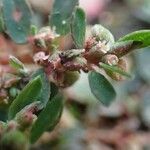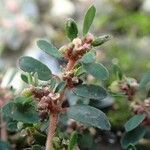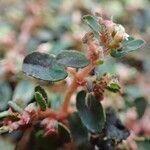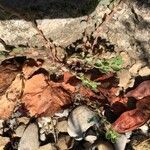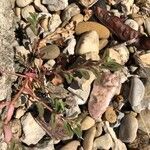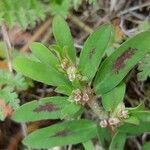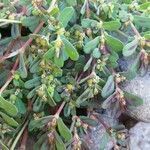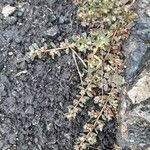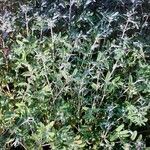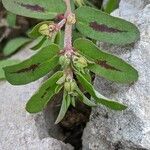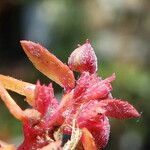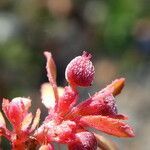Herbs, annual, 10-17 cm tall. Root fibrous, ca. 2 mm thick. Stems many from base, prostrate, ca. 1 mm thick, sparsely white pilose. Leaves opposite; stipules forming prickles, ciliate; petiole ca. 1 mm; leaf blade long elliptic to reniform-oblong, 6-12(-30) × 2-4(-13) mm, adaxially green, often with an oblong purple spot in middle, abaxially light green or gray-green, purple spot easily seen when fresh, invisible when dry, both surfaces glabrous, base obliquely slightly attenuate-rounded, margin entire below middle, finely serrulate above, apex obtuse. Cyathia from nodes, peduncle 1-2 mm; involucre narrowly cuplike, 0.7-1 × ca. 0.5 mm, white pubescent outside, marginal lobes 5, triangular-rounded; glands 4, yellow-green, transversely elliptic, appendages white. Male flowers 4 or 5, slightly exserted. Female flower exserted from involucre; ovary pilose; styles short, con-nate at base; stigma 2-lobed. Capsule 3-angular-ovoid, ca. 2 × 2 mm, smooth, sparsely pilose. Seeds ovoid-tetragonal, ca. 1 × 0.7 mm, gray or gray-brown, each side with 5 transverse furrows; caruncle absent. Fl. and fr. Apr-Sep.
Milk-purslane; spotted s. Annual; stems prostrate or nearly so, to 4 dm, often forming circular mats, sparsely to densely villous or villous-puberulent; lvs dark green, often with a red spot, oblong or ovate-oblong to linear-oblong, mostly 5–15 mm and a third to half as wide, often widest below the middle; involucre cleft on one side a fourth to a third of its length; ovary and fr strigose, the fr 1,5 mm; styles 0.3–0.4 mm, bifid a fourth to a third their length; seeds quadrangular, 1 mm, nearly smooth or with a few inconspicuous transverse ridges, becoming mucilaginous when wet; 2n=28. Very abundant as a weed in lawns, gardens, and waste places, also in meadows and open woods; Que. to N.D., s. to Fla. and Tex., and intr. as a weed elsewhere in the world. June–Sept. (E. supina; Chamaesyce m.)
Procumbent annual. Stems moderately to densely hairy, branched, up to 40 cm long. Lvs opposite, glabrous to sparsely hairy above, sparsely to moderately hairy below, shortly petiolate, finely serrate toward apex, usually oblong, acute or obtuse, asymmetric at base, (3)-5-10-(12) mm long, often with a purple spot about midvein; stipules lanceolate, entire, free, c. 1 mm long. Cyathia in small, axillary, leafy clusters along branches; subtending lvs like stem lvs. Glands ovate, with small white or purplish appendages. Capsules smooth, grooved, sparsely to moderately clothed in appressed hairs; keels sharp. Seeds rugulose, 4-angled, reddish brown, 0.7-1.0 mm long.
